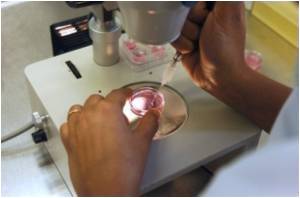Lack of laminin-332, a structural molecule of the skin, could be behind the extreme pain experienced by patients suffering from epidermolysis bullosa (EB), a hereditary skin disease.

Even the slightest touch causes a stinging sensation like being stabbed with pins; the body is covered with blisters and the skin is inflamed in many places. Young patients with epidermolysis bullosa are often called “butterfly children” because their skin is as fragile as a butterfly’s wing. Because of the severe pain associated with the disease, EB sufferers hardly have any chance to lead a normal life. Even walking is a torment because of the pressure on the soles of the feet.
Due to a genetic defect, the patients’ outer skin layer (epidermis) separates from the underlying skin layer (dermis), and blisters (bullosa) are formed. EB patients are deficient in laminin-332, a structural molecule normally found between the skin cells in the extracellular matrix which serves as a kind of cellular “glue” between the two skin layers.
The new findings of the MDC researchers show that in healthy individuals, laminin-332 has other important functions as well: It inhibits touch transduction and prevents the branching of the sensory neurons that are receptive to tactile stimuli in the skin.
At their endings, sensory neurons have mechanosensitive ion channels. These are proteins in the cell membrane through which charged particles can flow into the cell in a controlled manner. Upon touch, pressure on the extracellular matrix actuates a tether mechanism on the ion channels, thus opening the channels and allowing the charged particles to flow through. This excites the neuron, thus enabling the stimulus to be perceived.
In experiments using cell cultures, the MDC researchers found that physical stimuli trigger ion currents in all neurons not surrounded by laminin-332. In neurons growing on laminin-332, by contrast, the number of responsive cells was much reduced. “To a great extent, laminin-332 blocks the tether mechanism that opens the ion channels, thus impeding stimulus transduction. Because patients with epidermolysis bullosa are deficient in laminin-332, the transduction of the stimulus is unsuppressed. Their sensory neurons are excited much more strongly, and thus they react much more sensitively to mechanical stimuli,” Professor Lewin explained.
Advertisement
In further studies the researchers hope to find drug targets for therapy. However, much has already been achieved: “Because the causal mechanisms are now understood, we can focus on the patient’s pain situation and on administering more efficient pain therapies,” he added. “We recommend that in treating the disease, neurologists should be consulted in addition to dermatologists."
Advertisement
Source-Medindia













